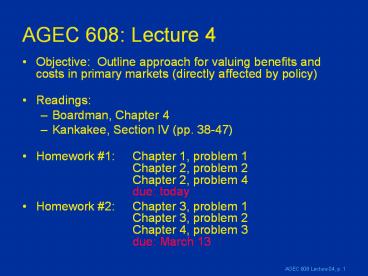AGEC 608 Lecture 04, p. 1 PowerPoint PPT Presentation
1 / 17
Title: AGEC 608 Lecture 04, p. 1
1
AGEC 608 Lecture 4
- Objective Outline approach for valuing benefits
and costs in primary markets (directly affected
by policy) - Readings
- Boardman, Chapter 4
- Kankakee, Section IV (pp. 38-47)
- Homework 1 Chapter 1, problem 1 Chapter 2,
problem 2 Chapter 2, problem 4 due today - Homework 2 Chapter 3, problem 1 Chapter 3,
problem 2 Chapter 4, problem 3 due March 13
2
Valuation in Primary Markets
A primary market is a market directly affected
by the policy change. Example The
government decides to build low- income housing.
The primary markets are those for housing and
building materials.
3
Valuation in Efficient Markets
General rule is that gross social benefit equals
net revenue of project plus any change in social
surplus. We ignore for now the cost of providing
the goods. Important caveat Typically we
use observed prices to value goods, but these
may not be good indicators of social values,
especially if markets are characterized by
monopoly, externalities, or asymmetric
information. In these cases, we need to use
shadow prices (more later).
4
Direct reduction in cost to consumers
Focus on direct movements in the supply curve
due to policy or project that directly affects
the supply of a good. Two possible
cases price not affected price is lowered for
all consumers
5
Case 1a good provided free, no price effects
- Assumptions
- 1. project increases available supply in a
well- functioning market by a small amount - 2. additional units of good are given away
- 3. increase in supply too small to affect
market price - Key insights
- 1. demand schedule is horizontal supply shifts
down - 2. consumer benefit is the measure of gross
benefit - 3. Net benefit depends on cost of provision
(later)
6
Case 1a good provided free, no price effects
7
Case 1b good provided at market price, no price
effects
- Assumptions
- 1. project increases available supply in a
well- functioning market by a small amount - 2. additional units of good are sold at market
price - 3. increase in supply too small to affect
market price - Key insights
- 1. demand schedule is horizontal supply shifts
down - 2. consumer benefit is transferred to
government as revenue, no double counting! - 3. Net benefit depends on cost of provision
(later)
8
Case 1b good provided at market price, no price
effects
9
Case 2a good provided free, market price changes
- Assumptions
- 1. project increases available supply in a
well- functioning market by a large amount - 2. additional units of good are given away
- 3. increase in supply leads to drop in market
price - Key insights
- 1. existing consumers gain surplus and
existing producers lose surplus (net impact
is abc) - 2. new consumers gain additional surplus
- 3. gross surplus is the combined impact, but
may be overstated since good is provided free
10
Case 2a good provided free, market price
changes
11
Case 2b good provided at market price, market
price changes
- Assumptions
- 1. project increases available supply in a
well- functioning market by a large amount - 2. additional units of good are sold at market
price 3. increase in supply leads to drop in
market price - Key insights
- 1. existing consumers gain surplus and
existing producers lose surplus (net impact
is the area abc) - 2. new consumers transfer additional surplus to
govt - 3. gross surplus is the combined impact
(q2cabq1)
12
Case 2b good provided at market price, market
price changes
13
Indirect reduction in cost to consumers due to
direct reduction in cost to suppliers
Focus on movements in the supply curve that
arise due to policy or project that has impacts
on the private producers of a good. Once again,
we ignore the cost of the government intervention
(i.e. this is a measure of gross surplus).
14
Shift in supply curve due to lowering of private
marginal cost
15
Valuing Inputs Opportunity Costs
Perfectly elasticsupply schedule cost of
government purchase (p x q') equals the social
opportunity cost of resources
16
Valuing Inputs Opportunity Costs
Perfectly inelasticsupply schedule cost of
government purchase (p x q) ignores lost consumer
surplus(triangle Pab)
Price a P
b
17
Valuing Inputs Opportunity Costs
With price effects social cost of q' equals
B G E FC is gain in social surplus and
must be netted out.

